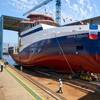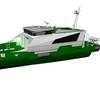QinetiQ’s Paramarine Selected by the Australian Maritime College
QinetiQ Maritime’s Paramarine ship and submersible design software has been selected by the Australian Maritime College (AMC) to use as part of their maritime engineering training program.
Through AMC’s National Center for Maritime Engineering and Hydrodynamics, the software will assist students on a four-year Bachelor of Engineering degree that is accredited by Engineers Australia and recognized worldwide.
“We selected Paramarine not only because of its extensive range of capabilities and functionality but also because it is so widely used by ship and submarine builders and designers around the world. We also wanted to ensure our students had exposure to and experience in using the design software used and recommended by many of our industry partners including the Australian DOD,” observed Dave Harte, Associate Lecturer, Maritime Engineering and Hydrodynamics, Australian Maritime College.
“We are very pleased to have been selected by the Australian Maritime College who along with the many other academic institutions around the world are using Paramarine to train many hundreds of naval architects. With the recent introduction of our latest version of the software, we believe we have the most functionally rich and modern ship and submersible design software available today,” said Vittorio Vagliani, Managing Director, QinetiQ GRC.
Paramarine is based on over 20 years’ experience in commercial and defence marine design. It is used by many of the world’s leading shipbuilders and ship designers, as well as some of the leading universities including the Massachusetts Institute of Technology and University College London. Its advanced design capabilities are built upon the Siemens PLM Parasolid solid modeller, which provides much of the geometric detail required to enable accurate analytical capabilities, as well as providing excellent geometric exchange with other CAD systems such as NX and Foran. The launch of the latest version of Paramarine (V8) has further extended the software’s functionality with the introduction of probabilistic damage modelling and assessment as well as enhancements to its emergency response, reporting, and stability assessment capabilities.










